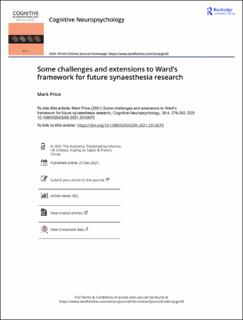| dc.contributor.author | Price, Mark | |
| dc.date.accessioned | 2022-02-17T08:59:26Z | |
| dc.date.available | 2022-02-17T08:59:26Z | |
| dc.date.created | 2022-01-13T12:25:48Z | |
| dc.date.issued | 2021 | |
| dc.identifier.issn | 0264-3294 | |
| dc.identifier.uri | https://hdl.handle.net/11250/2979562 | |
| dc.description.abstract | In his position paper on the future of synaesthesia research, Ward’s (2021) central argument is that the tendency to develop synaesthesia is just one consequence of a more general neurodevelopmental profile. He argues that the profile underlies many of the ways in which synaesthetes perform differently from controls in various mental tasks, even if there are still a few performance differences that are caused directly by synaesthesia. The profile impacts “lifestyle choices” such as careers. It is associated with an elevated tendency for autism and anxiety. Ward summarizes empirical evidence which suggests that this profile is shared by non-synaesthete near-relatives and appears strongest in those synaesthetes who experience many synaesthetic variants. These claims bring together much of the recent empirical work on synaesthesia and set out a useful scientific agenda.
Ward’s introduction emphasizes three points: (1) Synaesthesia is dichotomous – i.e., the presence versus absence of synaesthesia in any individual is bimodally distributed. You have it or you don’t, and there is no gradation. (2) Synaesthesia arises in a manner that is “probabilistic rather than deterministic”. (3) Research should be less concerned with synaesthesia itself, and more focused on the underlying neurodevelopmental profile. Here I present some challenges or extensions to these points (Italicized text in quotes is verbatim text from Ward’s paper.) | en_US |
| dc.language.iso | eng | en_US |
| dc.publisher | Routledge | en_US |
| dc.rights | Attribution-NonCommercial-NoDerivatives 4.0 Internasjonal | * |
| dc.rights.uri | http://creativecommons.org/licenses/by-nc-nd/4.0/deed.no | * |
| dc.title | Some challenges and extensions to Ward’s framework for future synaesthesia research | en_US |
| dc.type | Journal article | en_US |
| dc.type | Peer reviewed | en_US |
| dc.description.version | publishedVersion | en_US |
| dc.rights.holder | Copyright 2021 The Author(s) | en_US |
| cristin.ispublished | true | |
| cristin.fulltext | original | |
| cristin.qualitycode | 1 | |
| dc.identifier.doi | 10.1080/02643294.2021.2016670 | |
| dc.identifier.cristin | 1980362 | |
| dc.source.journal | Cognitive Neuropsychology | en_US |
| dc.source.pagenumber | 279-282 | en_US |
| dc.identifier.citation | Cognitive Neuropsychology. 2021, 38 (4), 279-282. | en_US |
| dc.source.volume | 38 | en_US |
| dc.source.issue | 4 | en_US |

